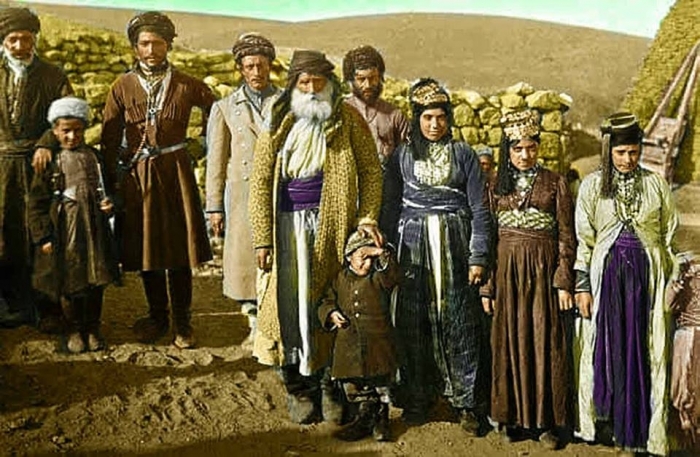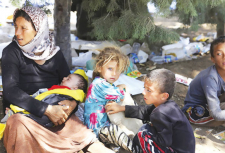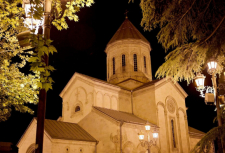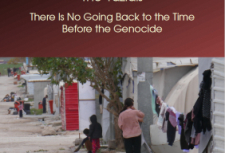On the structure of the yezidi clan and tribal system and its terminology among the yezidis of the Caucasus

Khanna Omarkhali
Introduction
Yazidis live mostly in Iraq, as well as in Syria, Iran, Turkey, and in post- Soviet states, particularly Armenia and Georgia; most of the community in these latter states settled there at the beginning of the 20th century. The economic hardships of the post-Soviet period forced a large number of the Yazidis from Armenia and Georgia to move to Russia. Yazidis live now also in the Ukraine. Many Yazidis have immigrated to Europe, notably to Germany; smaller numbers also live in France, Belgium, the Netherlands, the United States of America, and elsewhere.
Irrespective of the very great distance between different cities and even countries where Yazidis live, each Yazidis exactly knows to which caste and clan she belongs. For each representative of the Yazidi community, the knowledge of the name and history of the tribe and clan to which she belongs is extremely important even today, because this knowledge determines one’s position in Yazidi society, as well as relationships with representatives of other Yazidis tribes and clans and with certain individuals who play a role in one’s religious life. An individual orientates her/himself within Yazidi society and fulfils her/his religious obligations. This article will examine the structure of the clan and tribal system, mostly of the Yazidi community from Armenia, Georgia, Russia and the Ukraine. Practically all information given in this article is based on the gathered materials of my field investigations made among Yazidis from Armenia, Georgia, Russia and the Ukraine in recent years. In this research special consideration is also given to the problem of usage of different terms for tribes and clans of Yazidis, particularly in Armenia, Georgia and Russia, as well as some of those in Iraq, Turkey and Syria.
In this paper I give information, gathered during my research, about the four great Yazidis confederations of tribes who lived in the territory of the Ottoman Empire until the beginning of the twentieth century and then were forced to migrate to what is now Armenia. I will also give the names of the villages where Yazidis from each tribal confederation lived in the Ottoman Empire. I will describe the notions of caste, clan and home, and that of ‘tribe’ in particular with reference to its interaction with the category of caste. Next will be discussed the possible meanings of some of the clan names, and finally the roles of the five individuals with whom each Yazidis has a well-defined religious relationship of mutual obligation.
Caste system
Yazidism is not a missionary religion: belonging to a Yazidis society is inherited only by birth; all Yazidis society is based on the caste system, which gives it a united structure. All Yazidis are divided into three hereditary castes: pir, sheikh and murid. Pirs and sheikhs are the priesthood, which is generally called by the Yazidis from Armenia and Georgia terîq or ruhanî. Less often the term dunav is also used, though this is more frequently used in Iraq. According to my observation, the Yazidis priesthood (pirs and sheikhs together) constitutes approximately 6-7% of all general number of Yazidis; thus the remaining 93-94% are murids. Yazidis use general collective appellations for all representatives of each caste. Yazidis from the former USSR use the term Êzdîxane for all Yazidis, for all pirs - Pîranî, for all sheikhs - Sêxanî and for all murids - Mirîdxane.
Yezidi clans
Each caste is represented by many clans. Traditionally there are 40 clans of sheikhs and 40 clans of pirs. During my field investigations among Yezidis from Armenia, Georgia, Russia and the Ukraine, however, I managed to gather approximately 90 appellations of pir clans. Probably because Yezidis settled in different places in different countries, the number of clans increased over time as a result of their division. Division could be within one family: if there were a few brothers in one clan, each of them might become the founder of subclans (ber). For instance, there are some clans of pirs, such as pir Omerkhalî and pir Hesenchinêrî, who were brothers (see Qewlê Omerê Xala, Rashow 2004: 535-540), or pir Hejî Mihemed (bêzuret) and pir Jerwan, also brothers. Yezidis from Hesenchinêrî clan sometimes call the name of a clan, to which they belong, either ‘Hesenchinêrî’ or ‘Omerkhalî’. However, traditionally there are 40 clans of pirs and sheikhs, whose homes are called ocax. Terms of designating patronymic groups of Yezidis cause certain complexities which mostly arise from a certain interchangeability of terms in Kurdish for the designation of clans and tribes. In this paper I will attempt to present a clear view of an accurate usage of different terms for the Yezidi clans of laymen, as well as of the priesthood, by the Yezidis of Armenia, Georgia and Russia.
Tags: #yazidisinfo #yazidi #yezidi #ezidi
On the structure of the yezidi clan and tribal system and its terminology among the yezidis of the Caucasus

Khanna Omarkhali
Introduction
Yazidis live mostly in Iraq, as well as in Syria, Iran, Turkey, and in post- Soviet states, particularly Armenia and Georgia; most of the community in these latter states settled there at the beginning of the 20th century. The economic hardships of the post-Soviet period forced a large number of the Yazidis from Armenia and Georgia to move to Russia. Yazidis live now also in the Ukraine. Many Yazidis have immigrated to Europe, notably to Germany; smaller numbers also live in France, Belgium, the Netherlands, the United States of America, and elsewhere.
Irrespective of the very great distance between different cities and even countries where Yazidis live, each Yazidis exactly knows to which caste and clan she belongs. For each representative of the Yazidi community, the knowledge of the name and history of the tribe and clan to which she belongs is extremely important even today, because this knowledge determines one’s position in Yazidi society, as well as relationships with representatives of other Yazidis tribes and clans and with certain individuals who play a role in one’s religious life. An individual orientates her/himself within Yazidi society and fulfils her/his religious obligations. This article will examine the structure of the clan and tribal system, mostly of the Yazidi community from Armenia, Georgia, Russia and the Ukraine. Practically all information given in this article is based on the gathered materials of my field investigations made among Yazidis from Armenia, Georgia, Russia and the Ukraine in recent years. In this research special consideration is also given to the problem of usage of different terms for tribes and clans of Yazidis, particularly in Armenia, Georgia and Russia, as well as some of those in Iraq, Turkey and Syria.
In this paper I give information, gathered during my research, about the four great Yazidis confederations of tribes who lived in the territory of the Ottoman Empire until the beginning of the twentieth century and then were forced to migrate to what is now Armenia. I will also give the names of the villages where Yazidis from each tribal confederation lived in the Ottoman Empire. I will describe the notions of caste, clan and home, and that of ‘tribe’ in particular with reference to its interaction with the category of caste. Next will be discussed the possible meanings of some of the clan names, and finally the roles of the five individuals with whom each Yazidis has a well-defined religious relationship of mutual obligation.
Caste system
Yazidism is not a missionary religion: belonging to a Yazidis society is inherited only by birth; all Yazidis society is based on the caste system, which gives it a united structure. All Yazidis are divided into three hereditary castes: pir, sheikh and murid. Pirs and sheikhs are the priesthood, which is generally called by the Yazidis from Armenia and Georgia terîq or ruhanî. Less often the term dunav is also used, though this is more frequently used in Iraq. According to my observation, the Yazidis priesthood (pirs and sheikhs together) constitutes approximately 6-7% of all general number of Yazidis; thus the remaining 93-94% are murids. Yazidis use general collective appellations for all representatives of each caste. Yazidis from the former USSR use the term Êzdîxane for all Yazidis, for all pirs - Pîranî, for all sheikhs - Sêxanî and for all murids - Mirîdxane.
Yezidi clans
Each caste is represented by many clans. Traditionally there are 40 clans of sheikhs and 40 clans of pirs. During my field investigations among Yezidis from Armenia, Georgia, Russia and the Ukraine, however, I managed to gather approximately 90 appellations of pir clans. Probably because Yezidis settled in different places in different countries, the number of clans increased over time as a result of their division. Division could be within one family: if there were a few brothers in one clan, each of them might become the founder of subclans (ber). For instance, there are some clans of pirs, such as pir Omerkhalî and pir Hesenchinêrî, who were brothers (see Qewlê Omerê Xala, Rashow 2004: 535-540), or pir Hejî Mihemed (bêzuret) and pir Jerwan, also brothers. Yezidis from Hesenchinêrî clan sometimes call the name of a clan, to which they belong, either ‘Hesenchinêrî’ or ‘Omerkhalî’. However, traditionally there are 40 clans of pirs and sheikhs, whose homes are called ocax. Terms of designating patronymic groups of Yezidis cause certain complexities which mostly arise from a certain interchangeability of terms in Kurdish for the designation of clans and tribes. In this paper I will attempt to present a clear view of an accurate usage of different terms for the Yezidi clans of laymen, as well as of the priesthood, by the Yezidis of Armenia, Georgia and Russia.
Tags: #yazidisinfo #yazidi #yezidi #ezidi


























